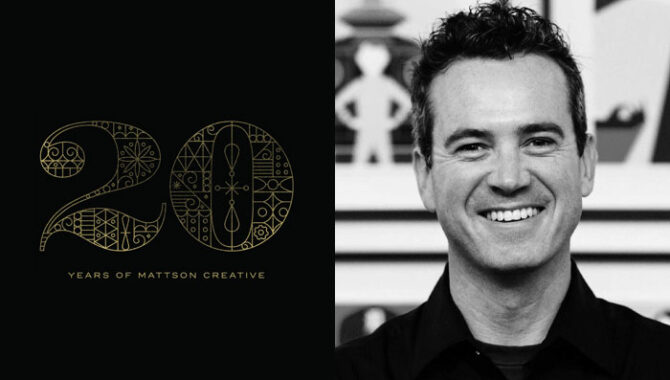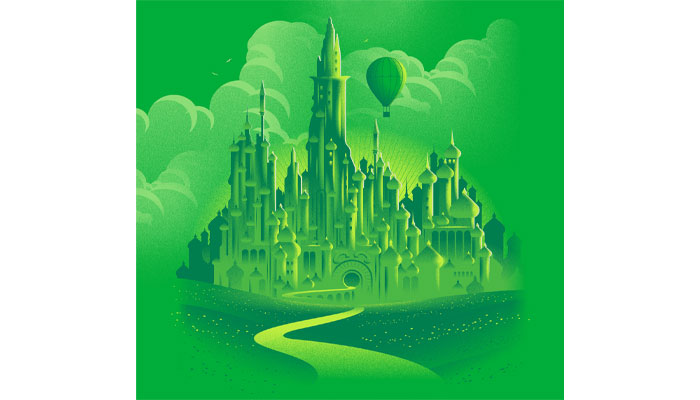—-
To stay in the loop with the latest features, news and interviews from the creative community around licensing, sign up to our weekly newsletter here

Mattson Creative’s Ty Mattson talks creativity, fandom – and The Wizard of Oz.
Ty, it’s great to connect. To kick off, let’s start at the beginning – how did Mattson Creative come to be? What’s the studio’s origin story?
Well, the origin story is essentially my origin story, which is essentially Superman’s origin story.
Ha! I knew I recognised you!
Ha! But in terms of how it all started, it began with all of the brands that inspired a young boy growing up in the late 70s, early 80s. It was comic books, the spinning rack at 7-Eleven and all the colours, illustrations, typography… Before I knew what those things were. It was those early stories – particularly Superman and DC properties – that captured my imagination, as well as Disney.
My dad was a Beta man – Betamax video recording was a big deal. The novelty of being able to capture The Wizard of Oz, when it would come onto television was great. We had all these videotapes of the movies that would play on TV… Most of them I don’t have the first five minutes of because that was when my mom would be yelling at my dad: “Bob, find a tape! Wizard of Oz is on!”
So Wizard of Oz was one of those you had recorded?
Yeah, I’ve seen Wizard of Oz maybe 300 times. And I’ve seen the beginning three times.

Ha! That must add an extra layer of nostalgia for you, seeing it in that format?
Yes, and are TV commercials that broke up that movie are as nostalgic for me as Judy Garland’s singing. So I grew up with pop culture and I was always drawn to the stories, characters, colours and sounds of it all. And because it was a little harder to get access to the actual stories in terms of the content, I gravitated towards the products – the toys, the action figures… These were stories I could now touch and feel and play with.
That shaped a lot of my career in that when I had an opportunity years later to work on a style guide project for a licensor, I felt like: ‘Oh, this is what I was made to do.”
Amazing, and what was that first project?
The first brand that I worked with in that way was the Discovery Channel. I started my company in late 2004 and, at that point, I was just trying to see if I could make a go of it. I was doing everything for anyone – and doing a lot of branding and logos, particularly for the home-building industry. Then, America in 2008 saw the beginning of a recession that was really driven by the home- building industry. That put a hold on a lot of the projects that I was working on.
“The usability of a style guide should never come at the cost of the marvelousness of it all.”
I then got a call from a freelance colleague of mine. He had an opportunity with Discovery Channel, but it was a crazy deadline and he couldn’t do it because he’d just taken an in-house job. He referred me to his client, and as soon as we connected, I thought: ‘This is it!’ It was the kind of work that I was always wanting to do – more illustrative, more colourful, more imaginative, more storytelling. Which had been a hard sell in the home-building industry.
And what did the Discovery Channel project entail?
I was asked to do packaging design for a pitch to Walmart around Bear Grylls – hang tags and things like that. And I had never contemplated designing a package system that would allow for multiple products or SKUs to be represented. It was a very different way of thinking for me, designing a system, But I understood the concept of consistency and the concept of having a brand. I understood the value of them from the corporate brand side, but a licensed consumer product style guide was so much more inspirational. It was about saying: ‘You could do something like this or something like that’. You could dream it up a little bit and I had fun with it.

This year has seen Mattson Creative celebrate its 20th anniversary, so can you talk me through what sorts of projects clients tend to come to you for?
We do packaging style guides, brand style guides for softlines and hardlines, brand identity work, and then retail is an area that we’re creating and applying imagination to.
You guys did a global brand and packaging guide for Wicked that looked terrific. In terms of how you prepped for that, did your 300 watches of Wizard of Oz play a role? Did being a fan aid the process?
I have a real reverence for The Wizard of Oz, so the idea of getting to work on anything connected to a story that shaped my imagination became this incredible opportunity to honour it. And that pressure does make for great work. They created so many of the sets practically, and Universal invited potential licensees to visit the set. It was incredible; I’d never seen anything like it before. I was so thrilled that I’d been on this journey from sitting in front of that television screen in the 80s, to walking into Oz – and I had designed my way there… I’d drawn pictures to get there. It was incredible.

So I do think being a fan – and the enthusiasm and reverence that comes with that – is important to the work. And you can be a fan of the specific property, or generally as a fan of storytelling, imagination and design. There are properties that I didn’t grow up with and that didn’t shape my imagination, but I’m a fan of the imagination that goes into them – and the audacity that they exist at all. I mean, Teenage Mutant Ninja Turtles, The Powerpuff Girls, SpongeBob SquarePants… These are mainstream, but it’s surreal, right?

Absolutely. Let’s dive into style guides – how do you ground all this passion into creative that works commercially?
That’s the magic trick! Usability is obviously very important in a style guide, but usability should never come at the cost of the marvelousness and fantasticness of it all. The usability should be almost invisible… When you see a product on the shelf, it should inspire you.
I’ll give you an example of how we’ve approached this. We were working with Universal on a style guide and packaging system for Jurassic World. We thought: ‘Could the packaging resemble a dinosaur cage?’ It’s a simple idea – there’ll be these very iconic cages with bars and metal and dinosaur scratches… We started to play with that idea, and the more we made it look like an actual cage, it got better and better. We then developed a system that could look very custom to whatever skew it was applied to – it could be scaled and utilised in every single way you could imagine. And it looked great.

So the usability is important, but that it’s not the only value I assign to it. It needs to be inspiring, and that tension between usable and inspiring is where we play.
What do you think are some of the key benefits to brand owners working with external creative agencies?
Probably the fearlessness of it. The independence and the distinction between the two entities creates a fearlessness and freshness. We are not necessarily aware of all of the different aspects, challenges, roadblocks, bureaucracies and systems. We come in as fans and we are free to make decisions, recommend ideas, play and explore. That sometimes is hard to do if you’re working in-house within a larger organisation, regardless of how amazing or creative you are – but that’s what we bring to the table when we get to collaborate with partners. It’s an agility and a different energy.
You work with some of the biggest licensors around – what do you think is key to fruitful creative partnerships between creative agencies and brand owners?
That’s a great question – we could talk about that for a long time! I’ve spent 20 years working with a lot of different studios, and the partnerships that have been the most successful are the ones that are a true partnership… Where we’re an appreciated partner and we’re building something together. It’s a relationship, right?

We need to have an incredible amount of empathy to understand a client’s company culture, so that we can work with it – and against it where you need to. There are cultures that really promote collaboration and there are cultures where your back is always up against the ropes. Ultimately, it all comes down to trust and appreciation. Compensation is a big part of that as well. If it’s a respectful relationship that’s appreciated, there’s going to be compensation that’s equal to the value of that partnership.

Before we wrap up, what fuels your creativity?
My environment is a big part of it. There’s this inner child that I work with – and have protected on some level… He still has that sense of awe and wonder that he felt when he saw the Wizard of Oz, or when he went to Disneyland, or when he asked his mom to take him to the comic book store. That collaboration with my inner child requires safety and protection, and this studio is filled with souvenirs and expressions of that same wonder and awe. It’s a safe place for that child to feel seen, recognised – and to then be a big part of the creative process.
Great answer – and a great looking studio! Ty, this has been a treat – thanks again for taking time out to chat.
Enter your details to receive Brands Untapped updates & news.